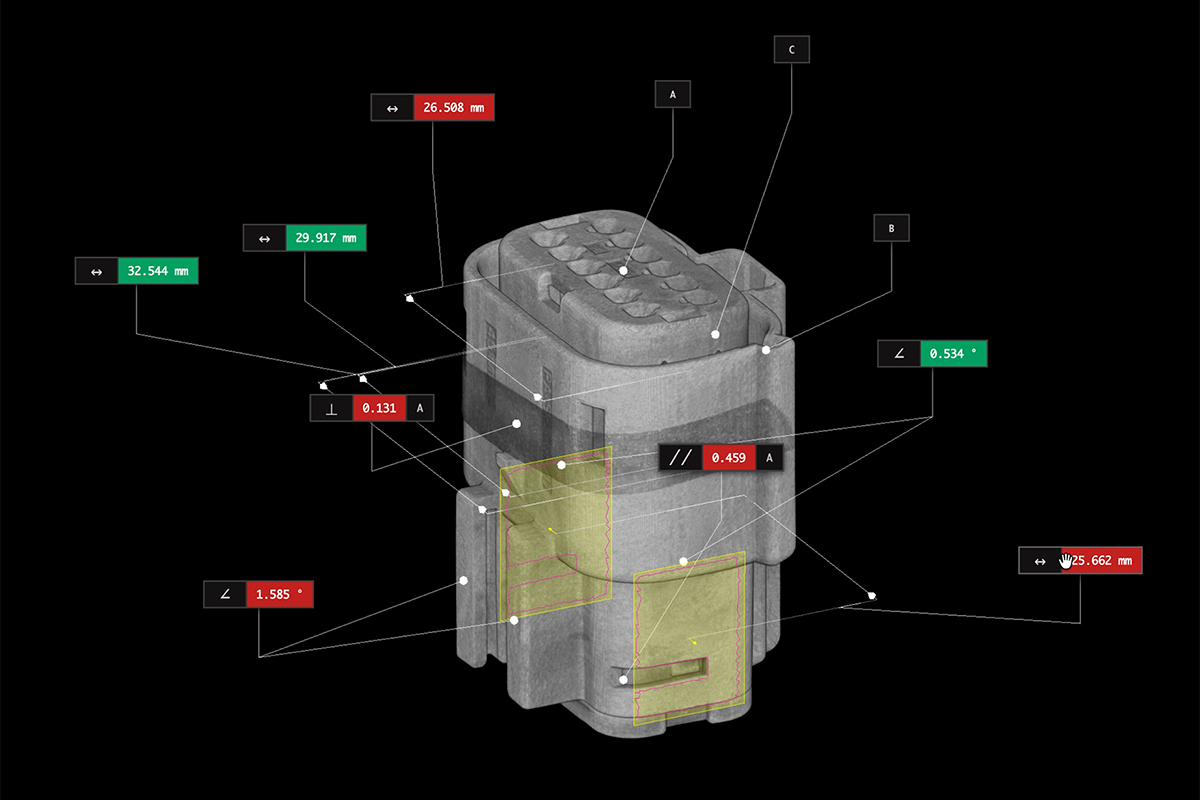Apple Vision Pro and Meta Quest Non-Destructive Teardown
Headsets built for virtual and augmented reality represent the bleeding edge of consumer electronics—packing high-resolution displays, immersive spatial audio, ultra-powerful processors, advanced sensor arrays, and inventive thermal management solutions into wearable devices. Offering gateways to other worlds requires that these headsets contain entire unseen universes of their own. To access them, we’ll need an imaging technology as advanced as these devices: industrial X-ray CT.
With our Neptune industrial CT scanner and Voyager analysis software, we conducted non-destructive teardowns of the Apple Vision Pro, Meta Quest Pro, and Meta Quest 3 headsets. The point of this exploration is not a head-to-head comparison or product review. Instead, we’re unpacking the way the divergent design philosophies and market strategies of Apple and Meta reveal themselves through hardware engineering.
Design
In our CT scans of the Apple Vision Pro, we discover a product that puts design first. Everything inside the Vision Pro is canted to make the most of the available internal space without detracting from the external contours of the brushed aluminum frame and laminated glass front plate. The main circuit board is built around a flexible PCB ribbon, and electronics are packed in here at different angles.
Give our 3D reconstruction a spin in the Voyager window below. Scroll up and down to zoom in and out.
Despite similarly curved exteriors, both the Quest Pro and newer Quest 3 house elements all stacked on a single plane. This traditional main board approach is time-tested and effective, especially for off-the-shelf components. In the Voyager viewer, click where you see 3D ▼ to change between the 3D and 2D views of the Quest Pro. You can choose between Cardinal X, Y, and Z. Once there, use the slider at the bottom of the viewer to scrub through the selected axis.
Internal layout already offers a key to understanding the design and engineering ethos behind these products. Apple’s designers are famous for giving their engineer colleagues tough challenges to deliver on ambitious hardware and software performance goals without compromising the overall look and feel of a device. Designers define the requirements, and engineers make it work.
The Meta headsets suggest not so much that the emphasis is reversed, but rather that the products have different priorities and target distinct markets. Apple, at least for now, is going all in for early adopters who are ready to drop $3,500 for a new kind of computer. Meta, meanwhile, pursues a design philosophy focused on ease of use and aimed at democratizing virtual reality by offering their headset at a more affordable price. At $500, the Quest 3 is 1/7th the price of the Vision Pro.
Displays
Even though all of these headsets feature video passthrough—a live feed of what your eyes would see—at the end of the day, none of them are glasses; they’re screens strapped to your face. In the case of the Vision Pro, that’s 2 micro-OLED Sony displays. These are screens that, according to Apple, have “more pixels than a 4K TV for each eye.” To be exact, that’s dual 3,680 x 3,140-pixel, micro-OLED displays. The Quest Pro offers dual LCD panels with 1800 x 1920 pixels per eye, while the Q3 clocks in at 2,064 x 2,208-pixel resolution.
Sensors
Meta's Quest devices incorporate handheld controllers complemented by an array of SLAM cameras, 3D thumbstick sensors, and action trigger pressure sensors, provide haptic feedback in addition to an intuitive control scheme. An experimental version of hand tracking, driven by inside-out cameras, has been part of Meta's OS since 2023.

The Vision Pro, on the other hand, leans heavily into eye and hand tracking for UI navigation, utilizing a complex sensor array including eye-tracking IR cameras, a LiDAR scanner, the TrueDepth camera system (used for FaceID on other Apple devices), downward-facing cameras for hand tracking, and MEMS microphones for voice commands.

The Quest 3 features a four-camera setup for spatial tracking and video passthrough, a Time of Flight sensor for depth sensing, showcasing a preference for infrared light over the more precise but costly LiDAR technology. Despite the Quest Pro initially planning to include a Time of Flight sensor, it was omitted in the final product, highlighting the trade-offs in sensor technology selection based on application needs and development timelines.
Processors
The processors in these headsets are the engines of their virtual experiences. The Vision Pro's heart beats with Apple's custom silicon, the M2 and R1 chips, designed to manage everything from display to spatial computing tasks. Meanwhile, the Meta Quest headsets rely on the Qualcomm Snapdragon XR2 platform.

Batteries
The Vision Pro opts for an external battery pack, prioritizing performance over onboard power storage. The Quest Pro, with its integrated but uniquely curved battery, strikes a balance between ergonomic design and user convenience. The Quest 3's approach is simpler, placing its battery front and center on the headset.

Thermal management
To manage the substantial heat generated by their powerful chips, VR headsets employ various cooling strategies. The Quest Pro utilizes a combination of active and passive cooling, featuring a copper heat pipe and two cooling fans. The Quest 3 simplifies with just one fan and omits the heat sink. Apple's Vision Pro, meanwhile, opts for a compact active cooling solution via micro-blowers, ensuring both the chip and display circuit board are kept cool. These fans, attached with thermal compound and set against a metal chassis—which likely serves as a passive cooling element—are designed for quiet operation and direct heat away from the user, enhancing comfort without compromising performance.

Audio systems
Immersive audio is pivotal in crafting virtual experiences that feel as real as they look. In the Vision Pro, these are powered by two "AudioPods" with a dual-driver setup, capable of delivering a surround sound experience tailored to the user's head and ear geometry. In the Quests, we see a more minimalist internal view but with the same approach of sound channeled directly into the wearer’s ear.

Conclusion
Meta’s two headsets demonstrate a striking economy of means. They deliver as much as possible using as little as possible. In many ways, the frugal construction and best-in-class value of the devices is as impressive a feat as Apple’s elegant vision statement. The comparison, if one holds, is between what their respective manufacturers call a “mixed reality VR headset” and a “spatial computer,” the latter hoping to usher in a new generation of technology and a new era of media to go along with it. Time, along with those of us who buy and use these, will tell which path wins out in reality—virtual, augmented, and otherwise.
Learn more
Are you an electronics engineer or product designer? Download our free Engineer’s Guide to Electronic Defects to discover:
- The most common culprits behind defects in electronic products
- How industrial CT scanning can accurately detect defects without the costly destruction of prototypes
- How industrial CT enables engineers to ability to scan, analyze, and share in higher quantity and in less time than ever before










